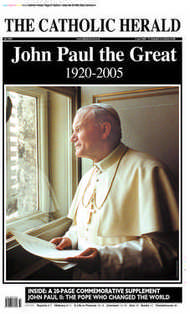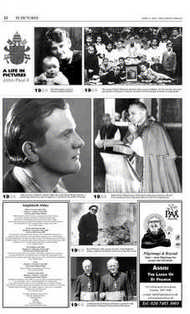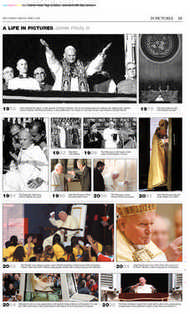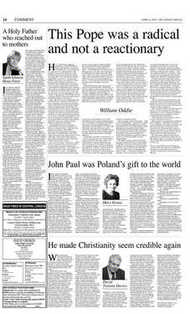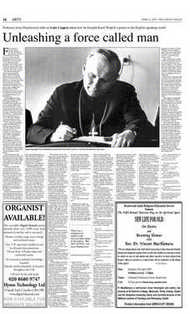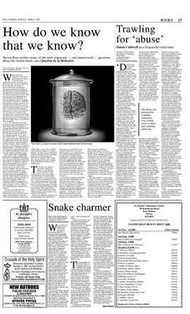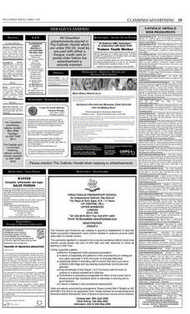Page 8, 8th April 2005
Page 8

Page 9

Page 10

Page 11

Report an error
Noticed an error on this page?If you've noticed an error in this article please click here to report it.
Tags
Share
Related articles
Pope John Paul Ii Superhero Comic Book Sells Out
The Achievement Of John Paul Ii
Charterhouse Chronicle
Charterhouse Chronicle
Pope Passes New Milestone
How ‘Lolek’ inherited the keys of St Peter
John Paul II’s life was one of the most dramatic, compelling and influential of the 20th century.
He was called out of obscurity to become the third longest-serving Pontiff in history
OBITUARY
John Paul II
POPE JOHN PAUL II was one of the most striking, interesting and influential figures of our times. This was an impression that grew ever stronger in his extraordinary old age. The visible pain and frailty of his final years had given rise to speculation of a possible retirement: and yet, these were the years in which not only the inner strength but also the radicalism of this supposedly conservative figure had become most apparent.
A tireless missionary, he was the first pope to visit all the inhabited continents of the world, drawing the largest crowds in history. He was the first to be fully at ease with the modern media, spreading the Christian message through television interviews, the internet, books and compact discs. He was the first officially to visit a synagogue or mosque, and the first to travel to Britain and Ireland. And he was the only pope to have acknowledged publicly the Church’s failings over two millennia.
For much of his reign, John Paul II had been – not only for the secular world but also for many Catholics – a figure of paradox. He was, it was said, a social progressive but an ecclesiological reactionary; a pastoral bishop who had been deeply influenced by the Second Vatican Council but who then – or so some critics volubly asserted – had directed his entire pontificate towards a restoration of the Catholicism of the pre-conciliar period. He was a defender of liberty wherever the rights of men and women were denied by despotic regimes, but his enemies soon began to claim that he himself silenced dissent among bishops and clergy quite as ruthlessly as any secular dictator. It seemed to many that he was wholly out of touch with the secular realities amid which he lived; yet few of his contemporaries had shown a more profound and subtle understanding of the nature of the historical forces that were to sweep away the postwar division of Europe, between the capitalist west and the Communist east.
Partly, these conflicting perceptions were based on a tendency to judge him by criteria which were either theologically superficial or wholly secular. The paradoxes were more apparent than real. Those, for instance, who saw a contradiction in a pope who forbade his clergy to become involved in politics, and yet who exercised an apparently direct political influence in his native Poland, failed to understand how his influence operated within a national culture which had a spiritual dimension from which the Marxist state was, in the nature of things, wholly disconnected. The political levers of power were never directly an object of his concern: and yet many of those in the Solidarity movement who did confront the Polish secular state were motivated by a Catholic humanism in which the dignity of beings made in the image of God was central, and which had been powerfully revitalised by their compatriot’s charismatic evangelical presence.
Karol Wojtyla’s anti-Communism was thus no merely ideological phenomenon: it derived from the same source as his critique of the entire modernist project. His thinking had evolved both as a result of his professional career as an academic philosopher and from the circumstances of his pastoral experience as priest and bishop. He believed that the secular mind – in both east and west – had installed cultures deeply inimical to the flourishing of the human personality. The enemy, for him, was anything – from relativism in moral philosophy to totalitarianism in politics – which obscured man’s nature as an essentially moral being. Man’s vocation was to become what God intended him to be: the drama of every human life was the struggle against evil, both personal and social.
This interaction between philosophy and pastoral reality can be seen in his theological focus on human sexuality. Modernism was focused on the norm of personal gratification – Pope John Paul’s personalist norm focused on the imperative to avoid using others. We had, he wrote, to meet the freedom of another person and depend on it. This could only be done within the context of permanent commitment, not as a means of confining the human personality but, on the contrary, as the only means by which sexuality can be truly liberated.
By the end of his life it was widely felt that he had won the intellectual argument within the Church. Though there were still those who perceived him as a reactionary pope who had sought to reverse the advances inaugurated by the Second Vatican Council, there were as many others who argued – if perhaps less loudly – that it was he who in the end was the council’s most definitive interpreter and advocate. In the words of the Jesuit theologian Cardinal Avery Dulles, more than any other single individual John Paul had succeeded in comprehensively restating the contours of Catholic faith in the light of Vatican II and in relation to post-conciliar developments in the Church and in the world.
This had certainly been his intention from the beginning. After his election he told the assembled cardinals that his “first task and definitive duty” was to complete the implementation of the Second Vatican Council. But he consistently refused to accept the view of some post-conciliar radicals that Vatican II represented a dramatic break with Catholic tradition.
“If anyone reads the council,” he declared in February 2000, “presuming that it marked a break with the past, while in reality it placed itself in line with the faith of all time, he definitely has gone astray.” It was part of the achievement of his pontificate that this understanding has been so widely accepted. An indication of how far opinion had shifted came with the publication in 1992 of the Catechism of the Catholic Church. Although it was largely the work of other hands, it was nevertheless a central part of John Paul’s own project. The Catechism had at first been seen by progressives as an irrelevant and essentially anti-conciliar document. But this analysis was rapidly falsified as this weighty volume became a massive best-seller and the undisputed touchstone of Catholic doctrine, of which it had effectively reestablished the objective and systematic character after decades of intellectual instability. Here, as elsewhere, John Paul II had reunited the See of Peter with the sensus fidelium, the deepest instinct of Catholic believers Karol Jozef Wojtyla was born in southern Poland as the nation was emerging from 150 years of foreign domination. The youngest son of Karol Wojtyla, a retired captain in the AustroHungarian army, and Emilia Kaczorowska, a cabinet-maker’s daughter, he was baptised on June 20, 1920 and known as “Lolek”. The future pope’s early life was marked by dramatic personal loss. When he was barely nine years old, his mother died, aged 45, from kidney failure. Three years later, his beloved brother, Edmund, a medical doctor 13 years his senior, died after contracting scarlet fever from a patient.
At 16, Wojtyla’s passionate and precocious interest in Polish literature drove him into amateur theatre. Working closely with a local avantgarde director he wrote, produced and acted in a series of experimental plays. In 1938, after coming top of his secondary school class, Wojtyla moved with his father to Poland’s cultural capital, Krakow, to study Polish language and literature at the ancient Jagiellonian University. His studies were interrupted the following year when Germany invaded Poland. The Second World War saw Wojtyla’s university professors sent to Sachsenhausen, while he himself was forced to work in a stone quarry to avoid deportation. The experience inspired him to become a lifelong champion of workers’ rights. He continued to write prolifically, producing a number of religiously-themed plays, novels and poems. He also organised and acted in clandestine theatre performances, at some risk to his life.
February 18, 1941, marked the third and greatest personal loss of Wojtyla’s youth. Returning home from the quarry, he found his father dead. The 20-yearold was taken in by family friends and began to live a life of intense prayer, guided by a mystical Krakow tailor, Jan Tyranowski. Sensing in himself an “interior illumination”, he decided to sacrifice his promising literary career to train for the priesthood.
In the autumn of 1942, he presented himself at Krakow’s underground seminary and was accepted. For the next three years he led a double life as a worker-seminarian, studying philosophy during night shifts at a chemical plant. If discovered by the Nazis, he would have faced execution by firing squad or Continued from Page Eight deportation to Auschwitz. On August 4, 1944, as the Germans began to lose their grip on Poland, the underground seminarians took refuge in the home of Cardinal Adam Stefan Sapieha, the Prince Archbishop of Krakow. Wojtyla narrowly avoided capture by the Germans, hiding in the basement as the Gestapo swept the upper floors of his house.
In January 1945 the Red Army liberated Poland, making it possible for Wojtyla to pursue his studies openly at the re-opened major seminary of Krakow and the theology faculty of the Jagiellonian University. He was ordained the following year, on All Saints Day, by Cardinal Sapieha and celebrated his first Mass in the crypt of Krakow’s Royal Cathedral, which houses the remains of Poland’s royal leaders. The setting, he said later, expressed his “special spiritual bond with the history of Poland”.
A fortnight after his ordination, Fr Wojtyla left Poland, for the first time in his life, to study at the Angelicum university in Rome. Under the tutelage of the French Dominican theologian Fr Garrigou Lagrange, Wojtyla wrote a thesis on St John of the Cross’s understanding of faith. His two-year course allowed him to “learn Rome” and discover the “universal dimension of the Church”. In the holidays, he travelled around Italy and northern Europe, ministering to migrant Polish workers in the coal mines of Belgium and meeting priests working as manual labourers in inner-city Paris.
In June 1948 Fr Wojtyla passed his doctoral examination, but failed to collect his degree because he could not afford to print his thesis. He returned in the same month to Poland to work as a curate and religion teacher in a rural parish. Less than a year later, he was transferred to the parish of St Florian in Krakow to begin a student chaplaincy. A “little family” of students quickly gathered around the charismatic young priest, who defied the Communist regime, and clerical convention, by leading mountain retreats and canoeing trips and giving weekly talks on religion. He saw these as a way of combating the aggressive atheism of Poland’s dictatorship and, by 1953, they had evolved into a twovolume anti-Communist catechism, circulated furtively among seminarians and Catholic intellectuals. During this period, Wojtyla also produced his most successful plays, Our God’s Brother and The Jeweller’s Shop, and his best long poem, “The Quarry”.
In September 1951, Wojtyla began a second doctorate at the Jagiellonian University, which he gained in January 1954. In October of the same year, he was appointed to the philosophy department of the Catholic University of Lublin, where he lectured on the philosophical ethics of Max Scheler, Immanuel Kant and Thomas Aquinas. In December 1956, he took the chair of ethics at the university and began a lecture programme on sexual ethics that culminated in 1960 in the daringly frank book, Love and Responsibility.
In July 1958, Pope Pius XII named Wojtyla auxiliary Bishop of Krakow. He was consecrated on September 28, a few months before Pope John XXIII convoked the Second Vatican Council. Bishop Wojtyla anticipated many of the ecumenical council’s themes in an essay to the preparatory committee, in which he urged that the “inalienable liberty and responsibility of the person” be the basis of all council documents. He also called for a special declaration on religious liberty, which he hoped could be used against the repressive Polish regime. He also appealed for the Church to become a bulwark for human rights, not just for its own flock, but for everyone.
Bishop Wojtyla crossed the Iron Curtain in October 1962 for the first session of the council. Over the next three years, he contributed to debates on liturgical reform, Revelation, the nature of the Church, dialogue with the world and religious freedom. Throughout he sided with the progressive bishops of northern and central Europe.
Shortly before he left for Rome, the See of Krakow fell vacant. For the next one-and-a-half years it remained empty as the Church sought to find a candidate acceptable both to Rome and the Communist regime. In 1963, the Primate of Poland, Cardinal Stefan Wyszynski, reluctantly nominated Bishop Wojtyla (apparently the eighth choice). The regime allowed his name to go forward, believing Wojtyla to be an apolitical intellectual, who would counter Wyszynski’s aggressive Polish nationalism. On December 10, 1963, Pope Paul VI named Wojtyla Metropolitan Archbishop of Krakow. On March 8, 1964, he was officially installed at the Royal Cathedral. At 43, he was the youngest bishop in Poland and, after Cardinal Wyszynski, the second most powerful.
As archbishop, Wojtyla found new and more effective ways to undermine the Communists’ grip on Polish society. By the time he became Pope, he had created almost 20 new parishes, each involving a struggle with the regime. He held secret ordinations, smuggled Catholic literature, protected the independence of the Church press, and created a network of lay synods, which gave Catholics a channel for community activism outside government control. In 1966, his campaign took on a national dimension when he joined Cardinal Wyszynski in a celebration of the millennium of Christianity in Poland.
Wojtyla’s election to the College of Cardinals in June 1967, at the unusually early age of 46, intensified his involvement in international Catholic affairs. He made speaking tours of the United States, Canada and Australia and frequent trips to Rome (when the regime allowed), attending synods of bishops and sitting on Vatican committees for liturgy, the clergy and Catholic education. He became a trusted adviser to Pope Paul VI, playing an important role in the development of Humanae Vitae, the Pope’s contentious encyclical prohibiting contraception. In 1976, Pope Paul gave Wojtyla his most explicit seal of approval, inviting him to preach the Lenten retreat at the Vatican.
Catholicism experienced a double blow two years later when the death of Paul VI was followed quickly by that of his successor, John Paul I, just 33 days after election. When the cardinals met again in Rome, it resulted in what had seemed unthinkable: the election of a non-Italian pope. Cardinal Wojtyla was elected on the fourth and decisive ballot on October 16. At 58, he was the youngest pope of the century, the first Slav to hold the office and the first non-Italian for almost 500 years. A collective gasp swept St Peter’s Square, and the watching world, when the election was announced. Moments later, in his first public appearance as Pope, John Paul II broke with custom by addressing the crowd in Italian, introducing himself to his bewildered new diocese as “a man called from a far country to start anew on this road of history and of the Church”.
John Paul II was solemnly inaugurated Pope at St Peter’s Basilica on October 22. In his first homily, he proclaimed a bold evangelical message to the world: “Do not be afraid! Open wide the doors for Christ. To His saving power open the boundaries of states, economic and political systems, the vast fields of culture, civilisation and development. Do not be afraid!” The final words became the leitmotif of his pontificate.
The following year, in his first encyclical, Redemptor Hominis (“The Redeemer of Man”), John Paul II laid the outline for his pontificate. The encyclical, which expounded Wojtyla’s distinctive Christian humanism, identified seven key tasks for the years ahead: to alert the world to the significance of the year 2000; to challenge Communism’s denial of religious freedom; to establish the moral foundations of a free society; to oversee the full implementation of Vatican II; to restore unity within the Catholic Church; to pursue full Christian unity and dialogue with world religions.
Hours after John Paul II’s election, Cardinal Wyszynski had taken the new Pope aside and told him God had chosen him to lead the Church into the third millennium. The prophecy left a Continued from Page Nine deep impression on him and his first encyclical focused on the coming millennium from the opening paragraph. The Church was living, he wrote, in a new season of expectation, looking forward to a renewal of faith 2,000 years after the birth of Christ.
Wyszynski’s prophecy was confirmed, for John Paul II, on May 12, 1981, when the Pope was shot in St Peter’s Square by a Turkish terrorist, Mehmet Ali Agca. The assassin’s bullet came within a fraction of ending his life, leading him to say later that “one hand fired the gun and another guided the bullet”. Agca, who had acquired the gun in Bulgaria, was widely thought at the time to have acted on Moscow’s orders. John Paul II attributed his miraculous escape to Our Lady of Fatima, on whose feast day the attack fell. “In the designs of providence there are no mere coincidences,” he said at the Portuguese shrine the following year.
Karol Wojtyla did not come to the papacy with an explicit plan for dismantling the Communist bloc. But by relentlessly focusing on human rights, particularly the primary right to religious freedom, he attacked the heart of the Communist project – its claim to be the 20th century’s true humanism and liberator. In June 1979 he took the message to his homeland. During a nine-day pilgrimage to Poland, in which he addressed a rapturous third of his countrymen, he chastised the Polish regime for repressing the country’s deep religious heritage.
Speaking to an estimated million people in Warsaw’s Victory Square, with Poland’s premier Edward Gierek watching anxiously from a nearby hotel, he proclaimed that without Christ it was impossible to understand the history of Poland. His visit left the nation stirred and eager to enact the national moral renewal for which he had called. Barely a year later, the Polish government sanctioned the Communist bloc’s first independent, self-governing trade union, Solidarity.
John Paul II was informed in December 1980 that the Soviet Union was massing troops on the Polish border in order to crush Solidarity. He wrote a bold letter to the Soviet leader Leonid Brezhnev, urging him not to invade. The danger passed, but a year later Poland’s military dictator, General Jaruselski, declared martial law and arrested the Solidarity leadership. Leading prayers in the Vatican, the Pope pleaded with the General to put “an end to the shedding of Polish blood”. Poland, he said, was “important not only for a single country but for the history of the world”.
His intuition was confirmed over the next eight years as the Communist bloc unravelled with unexpected speed. In 1989, the year of the fall of the Berlin Wall, and of the first free election in Poland, was John Paul II’s annus mirabilis and was capped by the December visit of a humbled Mikhail Gorbachev to the Vatican. John Paul told the leader of the Soviet Union (who considered the Pope “a providential man”) that their meeting was “a singularly meaningful event, a sign of the times and a sign that is rich with promise”. Interpretations of the Pope’s role in the collapse of European Communism would vary wildly, but there was wide agreement that he was indispensable in shaping the revolution of conscience that had preceded, and made possible, the non violent political revolution of 1989.
With Communism vanquished, John Paul II sensed that the newborn democracies of eastern Europe faced massive new challenges. The first task, he believed, was to build a free society upon solid ethical foundations. In a trio of major encyclicals, beginning in 1991 with Centesimus Annus (“The Hundreth Year”), he offered a blueprint. The encyclical argued that democratic societies had to be grounded in a respect for the fundamental freedom and dignity of the human person. A democracy without values easily turned into open or thinly disguised totalitarianism, John Paul wrote. Communism’s error was to reduce human beings to economic units. Without fundamental values, capitalism would do the same.
He further elaborated his vision in the landmark 1993 encyclical Veritatis Splendor (“The Splendour of Truth”), on the fundamentals of the Church’s moral teaching. The encyclical evaluated the modern crisis of moral relativism, linking the recognition of universal moral norms to democratic equality, the defence of the socially marginal and the just distribution of wealth and integrity in government.
His third effort to establish the moral basis of life in democratic societies was the 1995 encyclical Evangelium Vitae (“The Gospel of Life”), which argued that democracies risked self-destruction if moral wrongs were legally defended as rights. Democracies that denied the inalienable right to life from conception until natural death were tyrant states that created a pervasive “culture of death” in which abortion, euthanasia and the death penalty were actively promoted. He appealed for the creation of a new “culture of life”, which defended the dignity of every human life.
If this was John Paul II’s challenge to the world, his challenge to the Catholic Church was to absorb fully the teachings of Vatican II before the coming of the year 2000. Many Catholics, he believed, had failed to grasp the council’s true meaning. Vatican II was not, he argued, a political struggle between conservative and progressive factions in the Church hierarchy. It was a major religious event aimed at strengthening the evangelical and apostolic life of the Church for the next millennium. In his first encyclical, he had sought to draw a line under the bitter infighting that followed the council, warning Catholics against making thoughtless criticisms, and calling theologians to close collaboration with the Magisterium.
His comments were interpreted as signalling a crackdown on dissenting Catholic theologians, a view given further credence in December 1979 when he disciplined the outspoken German theologian Hans Küng. Over the next 20 years the Pope took action against half a dozen more theologians. But his greatest intellectual confrontation came in 1979 on his first visit to Latin America.
With revolutionary tumult sweeping the continent, Catholic theologians were demanding that the Church ally herself with the poor in a Marxist-influenced struggle for justice. In a crucial speech to the Latin American bishops, John Paul argued that such liberation theologies reduced the kingdom of God to a political, secularised kingdom. The Church was committed to the poor, but did not need to have recourse to ideological systems in order to love, defend, and collaborate in the liberation of man.
The Pope’s concern to secure the legacy of Vatican II also took positive forms. In 1983, he produced the longawaited revised Code of Canon Law and, in 1992, issued the universal Catechism of the Catholic Church, which became an international bestseller. While his detractors accused him of being autocratic, and of centralising ecclesial authority excessively in Rome, he spent more time meeting the Church’s bishops than any other pope in modern history.
This openness to his fellow bishops revealed the radical way in which John Paul II conceived the office of pope. He brought a new style of leadership to the Vatican, shunning the bureaucratic style of previous papacies for a pastorally and evangelically assertive ministry. The purpose of the papacy, he believed, was not to seek worldly power, but to present the Gospel to the world. As he explained in his 1990 encyclical Redemptoris Missio (“The Mission of the Redeemer”): “The Church proposes; she imposes nothing.” He believed that this mission demanded he travel the world preaching the Gospel. His energetic, relentless journeys made him the most visible pope in history. Millions saw him in person and billions more on television as he made whistle-stop tarmackissing, hand-shaking, baby-hugging, crowd-blessing tours of the five inhabited continents. His innovatory World Youth Days drew millions of young people, including the largest crowd in human history at Manila in 1995. He used every available medium to spread his message, becoming the first pontiff to publish a personal book, the best-selling Crossing the Threshold of Hope, which was translated into more than 40 languages.
His travels also allowed him to exercise a distinctive style of international diplomacy. He sought to challenge and embarrass repressive regimes during his visits by emphasising the inalienable dignity and the rights of every human person. The approach scored notable successes in Chile, Nicaragua, the Philippines, Nigeria and Cuba. He also built a Continued on Page Eleven Continued from Page Ten unique moral profile in world affairs through his regular audiences at the Vatican. Determined to become the voice of those who could not speak or who were silenced, he insistently called for world peace, condemning conflicts as far removed as the Balkans, Iraq and the Falkland Islands.
The first ever papal pilgrimage to England in 1982, at the height of the Falklands conflict, was a golden opportunity for John Paul II to show his commitment to the quest for Christian unity. The historic prayer service at Canterbury Cathedral with the Archbishop of Canterbury, Robert Runcie, marked the highest point of relations between the Anglican and Catholic Churches since the Reformation. Hopes of imminent unity, however, were shattered when the Church of England opted to ordain women to the priesthood. John Paul II insisted – to the chagrin of a vocal minority of Catholics – that the Church had no authority whatsoever to ordain women. By the end of the 1980s, the Pope and the Archbishop of Canterbury frankly acknowledged that they saw no solution to the impasse.
John Paul placed more hope in the reunion of the Catholic and Orthodox Churches. His first steps towards unity came in 1979 with a visit to the Ecumenical Patriarch of Constantinople and the opening of formal dialogue between Orthodox and Catholic theologians. By December 1987, when he received the Patriarch on a five-day pilgrimage to Rome, he could state that there were no theological reasons why the two Churches could not become one.
But it was politics, rather than theology, that disappointed the Pope’s millennial hope for unity. After the collapse of Communism a resurgent Russian Orthodox Church complained of Catholic proselytism and was deeply angered by the decision to create Catholic administrative territories in the former USSR without prior consultation. Although he never fulfilled his dream to visit Moscow, John Paul travelled to Athens in May 2001, where he offered an apology for Catholic aggression to the Greek Orthodox leader, Archbishop Christodoulos. A month later, he visited Ukraine, the world’s main Catholic-Orthodox flashpoint. Although his visit eased tensions, it did not bring the unity between the two sister Churches which he so desired.
John Paul II, however, remained convinced that unity was God’s will for the Church. He expressed this powerfully in his 1995 encyclical Ut Unum Sint (“That They May be One”), where he affirmed the Catholic Church’s irrevocable commitment to unity. In a remarkable passage, he asked Orthodox, Anglican and Protestant Christians to help him redesign the papacy as an office of unity for the whole Church of Christ.
Unity among Christians was not enough; the Pope sought harmony and understanding among all the world’s religions. To this end, he called a historic meeting of religious leaders to pray for peace in Assisi in October 1986. A year earlier he had addressed 80,000 Muslim youths on the impor tance of peaceful co-existence between Christianity and Islam. But the Pope’s most significant encounter with the Islamic world came in May 2001, when he became the first pontiff officially to visit a mosque, in Damascus, Syria.
But it was Christianity’s relationship with Judaism that most captivated him. In April 1986, he became the first pope to visit Rome’s synagogue, where he stressed that the Jews were still God’s chosen people and called them Christianity’s “privileged elder brothers”. This new relationship between the two faiths was consolidated in 1993, when Israel and the Holy See forged a landmark fundamental agreement leading to full diplomatic relations.
Five years later the Vatican published a document asking forgiveness for 2000 years of Catholic “antiJudaism”. But it was John Paul’s visit to the Holy Land in March 2000 that truly marked a break with two millennia of Christian-Jewish hostility. At the end of the week-long visit, which included a stop at Jerusalem’s Holocaust museum, the Pope placed a prayer in the Western Wall, regretting Christian hostility to Jews and hoping for “a new era of fraternal dialogue in the third millennium”.
The trip to Israel forced many observers to reassess an extraordinary pontificate. Over the preceding two decades, John Paul II had become the longest serving pope of the 20th century. He had made more than 90 foreign pilgrimages, delivering some 3,000 addresses to hundreds of millions of men, women and children. He had written more than a dozen encyclicals and three dozen apostolic letters. He had canonised more new saints than all the other popes in history combined. He had held over 1,000 general audiences, attended by more than 16 million people, created more than 200 new cardinals and 3,000 bishops, and established diplomatic relations with more than 60 countries. This astonishing work-rate took its toll.
From the mid-1990s, the Pope’s health deteriorated and the ebullient, dashing figure of the 1980s became a visibly strained old man. In the last decade of his life, John Paul II battled with physical debilities that included internal injuries, a fractured femur, a hip prosthesis and chronic pain from cartilage problems. The Pope, John Paul said after surgery in 1994, “had to suffer” in order to purify the Church for the third millennium. But despite his physical limitations, he said he continued to enjoy life. “It is wonderful to be able to give oneself to the very end for the sake of the Kingdom of God,” he said in a 1999 message to older people.
On Christmas Eve 1999, John Paul II walked through the Holy Door of St Peter’s, signalling the start of the Great Jubilee of the Year 2000. The Jubilee, which he had looked forward to since his election, would, he predicted, herald a new springtime of Christian life. The surprises of the pontificate were not yet over. In January, he knelt sideby-side with the Archbishop of Canterbury and a Greek Orthodox Metropolitan for the opening of the Holy Door of St Paul’s Outside the Walls. In February, he received more than 20,000 sick and terminally ill people in St Peter’s Square for a special Mass.
In March, he held a day of pardon in which he asked God’s forgiveness for the sins of Catholics over the past 2,000 years. He hoped the ceremony would lead to a “purification of memory” and prepare the Church to bring the Gospel to the people of the new millennium. In May, he revealed the third secret of the Fatima visionaries, which predicted the 1981 attempt on his life. In the same month, he celebrated the world’s first ecumenical commemoration of the 20th century’s 13,000 Christian martyrs.
In August, the Pope preached to the largest gathering in European history. More than two million young people from 160 countries were present for the closing World Youth Day Mass in Rome. The Pontiff challenged his young congregation to “set the world ablaze” with Christian fervour. In September, he beatified two predecessors, Pius IX, who called the First Vatican Council, and John XXIII, who called the second. The following month, he led the world’s bishops in a collective consecration of the new millennium to the Blessed Virgin Mary. In November, at a Jubilee gathering of politicians, he declared St Thomas More patron of statesmen.
On January 6, 2001, after a year of special events for Catholics from all professions and states of life, he marked the end of the Jubilee Year by shutting the holy doors. On the same day, he signed the apostolic letter, Novo Millennio Ineunte (“At the Beginning of the New Millennium”), which exhorted the Church to deepen its commitment to prayer and mission. The Jubilee Year, the Pope wrote, had given the Church a special time to reflect on her condition three decades after the Second Vatican Council. The council, which he described as “the great grace bestowed on the Church in the 20th century”, was a “sure compass” showing the Church’s direction in the new millennium.
In February, John Paul II brought the depleted College of Cardinals back to full strength, adding 43 new members at the largest consistory in the Church’s history. The consistory consolidated the Pope’s influence over the body which would elect his successor, but raised eyebrows by the inclusion of both moderates and hard-liners. Studied closely, the nominations reflected John Paul’s global strategy for creating a dynamic and evangelically assertive Church and his disregard for the conventional labels of Church politics.
Following the September 11 atrocity the Pope displayed his uncanny sense of timing, flying to Kazakhstan on the eve of the bombing of Afghanistan. With the warplanes reportedly waiting for him to return to Rome, he condemned violence in the name of religion and issued a powerful call for peace.
It was an act typical of a man who had participated in the great political and intellectual conflicts of the late20th century; who had defended the human rights of millions around the world; who had set out a compelling vision of moral life in an age of relativism; who had injected new urgency into the Christian faith: a man who may be remembered as one of the prophets of the new millennium, and one of the greatest popes of the last.
Pope John Paul II was born Karol Jozef Wojtyla in Wadowice, Poland on May 18, 1920. He died on April 2, 2005, aged 84.
This obituary is reproduced with the kind permission of The Times
blog comments powered by Disqus


